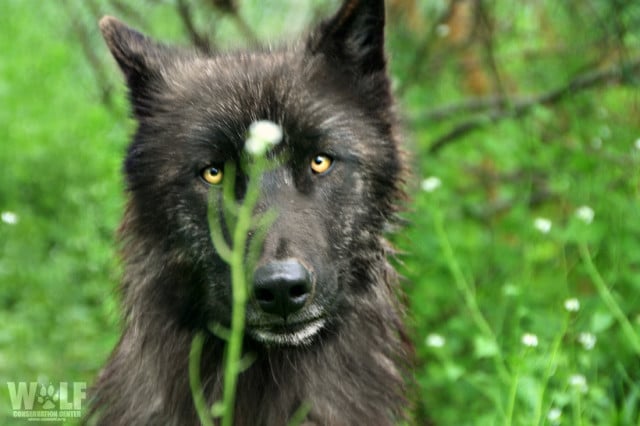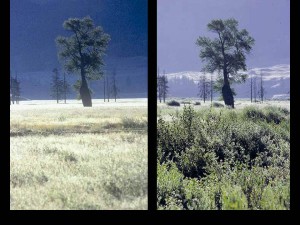How Wolves Impact Biodiversity And Ecosystem Services
August 28, 2016 | Uncategorized

Wolves: A Critical Keystone Species
An ecosystem is a biological customs of interacting organisms and their physical environment. It includes all of the living things interacting with each other and non-living environments (weather, earth, dominicus, soil, climate, atmosphere) in a given area.
In an ecosystem, all species rely on each other and each organism has its' own niche or role to play. A keystone species is a constitute or animal that plays a unduly large part in the ecosystem – impacting both the prevalence and population levels of other species inside their customs. A keystone species is often, but not always, a predator. Outnumbered profoundly by their prey, predators tin can control the distribution and population of large numbers of casualty species.
Wolves are a critical keystone species in a healthy ecosystem. By regulating prey populations, wolves enable many other species of plants and animals to flourish. In this regard, wolves initiate a domino issue – "touching" songbirds, beaver, fish, and butterflies. Without predators, such as wolves, the arrangement fails to support a natural level of biodiversity.
"I at present suspect that just every bit a deer herd lives in mortal fear of its wolves, so does a mountain live in mortal fear of its deer. And perhaps with better crusade, for while a buck pulled down by wolves can be replaced in two or three years, a range pulled down by too many deer may fail of replacement in as many decades." ~Aldo Leopold, A Sand County Almanac
Yellowstone: A Wild Homecoming
The recovery of the gray wolf after its eradication from Yellowstone National Park, nearly a century ago, serves as a demonstration of how critical keystone species are to the long-term sustainability of the ecosystems they inhabit. In the 70-year absence of wolves in the Park, elk had become accepted to grazing tender, native willows forth stream banks without much predation risk. The consequences of an elk population without a tiptop predator included a refuse of the deciduous copse elk eat, a decline of beavers due to the pass up of willow and aspen, and a turn down in songbirds. These consequences signal that changes in the wolf population have trickle-downward effects on other populations, a phenomenon known every bit a "trophic cascade".
With the support of the American public 2 decades ago, the federal regime gave the green light to return wolves to portions of their native range in the Due west in 1995 and 1996 – including Yellowstone. The wildlife conservation issue opened a new chapter in Yellowstone's history, with a homecoming that inverse the Park.

After wolf reintroduction, scientists documented the render of willows and other vegetation. And where the willow returned, the researchers noted more diverse wildlife. Beaver dams and dried upwardly wetlands returned, and wetland birds, waterfowl and other wildlife thrived again where they had been suppressed for decades. Over-grazed grasses flourished afresh on upland prairies. So without keystone species, ecosystems tin be dramatically dissimilar or end to exist altogether.
Wolves: Nature's Phenomenon Workers?
Ecosystems are complex and the reintroduction of wolves to Yellowstone might be far more than complicated and nuanced than can be explained past trophic cascade. Trophic Cascades in the Yellowstone ecosystem take to do with a variety of environmental conditions including burn, wolf densities, man hunting of wildlife, conditions patterns, stochastic effects, etc… Research washed in all sorts of systems – from coral reefs to rain-forests to the rocky inter-tidal zone to lakes – shows the complication of these relationships and demonstrates that there are situations where a keystone may be present just non driving a potent summit-down effect. It is of import to recall that we exercise not live in an exclusively top-downwardly or lesser-up earth. We live in a earth in which these effects work together to construction plant communities. The wolf is a very powerful role player in this, simply is not the only factor that affects ecosystem structure and role. Context matters. While wolves definitely initiate trophic cascades that better ecosystem role, wolves are not a panacea for all that'south wrong in an ecosystem. This existence said, wolves are an essential component of healthy ecosystems and thus should be conserved. To do anything other than that is actually foolish, given all that scientific discipline has taught u.s.a..
Wolves are wildlife managers, simply not miracle workers, alas…
How Wolves Impact Biodiversity And Ecosystem Services,
Source: https://nywolf.org/2016/08/wolves-are-a-critical-keystone-species-in-a-healthy-ecosystem/
Posted by: emersonroince.blogspot.com


0 Response to "How Wolves Impact Biodiversity And Ecosystem Services"
Post a Comment